Chronic Bike Saddle Discomfort, Part 3 – Too Much Pressure on the Sit Bones.
There are so many potential reasons for chronic bike saddle discomfort that it would be overwhelming and confusing to try to cover them in a single article. For this reason, we are exploring potential riding technique and postural items (by far the biggest contributors to chronic saddle issues) one at a time so that you can hopefully gain a better understanding of why you may be experiencing saddle issues. The first two articles in this saddle discomfort series have focused on technique items that generally lead to discomfort on the soft tissue at the front of the saddle – toe pointing through the front of the stroke and hyper-extension of the back while riding. In this article, we’ll focus on the other end – too much pressure on the sit bones leading to soreness.
What is Pelvic Under-Rotation when Riding a Bike?
 Pelvic under-rotation (posterior/rearward tilt) is the act of sitting on the bike saddle with a pelvic angle much like you would have when sitting in a kitchen chair and then bending in the back to reach the handlebars. Simply put, it is “hunching” or “slouching” while riding – also known as kyphosis.
Pelvic under-rotation (posterior/rearward tilt) is the act of sitting on the bike saddle with a pelvic angle much like you would have when sitting in a kitchen chair and then bending in the back to reach the handlebars. Simply put, it is “hunching” or “slouching” while riding – also known as kyphosis.
What is Pelvic Over-Rotation when Riding a Bike?
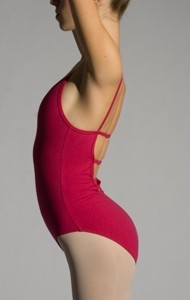
Pelvic over-rotation (anterior/forward tilt) is the act of sitting on the bike saddle with a pelvic angle that is rotated far forward, thus pulling the support structure of the torso out of the abdominal muscles and instead applying it more into the back muscles. This frequently leads to hyper-extension (lordosis) of the back, which is exceptionally common with cyclists.
How Does Under-Rotation of Your Pelvis Potentially Contribute to Sit Bone Pain and Saddle Discomfort on a Bike?
While hunching to get low and aero can work okay for short periods (and longer periods for riders with well developed abdominal control), it often encourages riders to brace and push to the back of the saddle. This loads up the back/neck and shoulders significantly while contributing to pressure points on the hands and wrists and it can lead to problematic pressure points directly on the ischial tuberosities/sit bones.
How Does Over-Rotation of your Pelvis Potentially Contribute to Sit Bone Pain and Saddle Discomfort on a Bike?
Many riders who exhibit hyper-extension (lordosis) on the bike cannot use their abdominal muscles (and often glutes) to support their pelvis or torso weight and thus tend to overuse their back, arm and neck muscles. They will often brace against the handlebars and push towards the back of the seat and thus overweight the sit bones. These riders also have a tendency to have lateral muscle balance issues and rock more in the saddle and are thus also prone to uneven pressure on the sit bones left to right.
“How Should I Support Myself on the Bike Posturally?”
From a musculature standpoint, your goal when pedaling is to use your core/abdominal muscles to keep yourself stable in the saddle while supporting the weight of your torso (thus allowing you to relax your extremities and joints). This has similarities to the posture and muscles you use in the “ready” position in a ball sport (pelvis rotates slightly forward, quads/hamstrings/abdominals all balance you out and support your torso and you are relaxed in the upper body and hands). If you master this fundamental posture in general riding, you will find that keeping your weight in a balanced place that distributes weight from your weight through your middle pelvic platform (not just on your sit bones) is much easier. This in turn will reduce your desire to tighten your back muscles, hunch your back in kyphosis, hyperextend into lordosis, brace with straight arms, or push way back on the saddle. 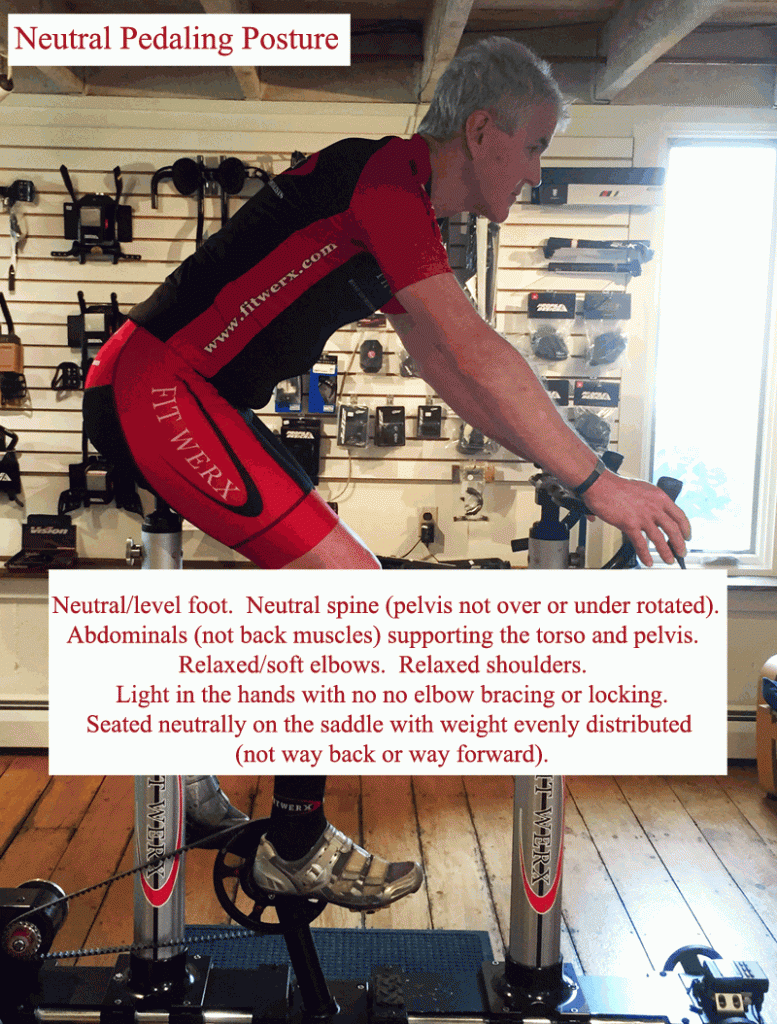
What Should I be Aware of when Pedaling that Can Put More Pressure on my Saddle?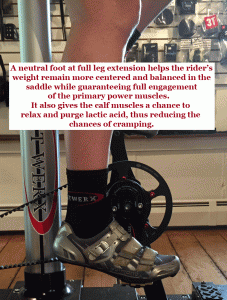
This is a broad topic that is very subjective and something we often spend a lot of time analyzing and working with riders on during their bike fittings. This being said, riders who have too much pressure on their saddle often use a pedaling style where they drive their heels down too low at the bottom and/or front of the pedal stroke. If you drive your heels down – even for just a split second – it can increase saddle pressure markedly. Your knees should never approach hyper-extension when pedaling. If they do, you will likely increase saddle pressure. Through the front to bottom of the stroke, your foot should be “cycling level” with a neutral forefoot (see picture of neutral foot). If the heel is lower than the picture, with an optimal saddle height, the rider will feel saddle pressure.
What are Some Set-up Variables that Encourage Over Rotation of the Pelvis?
• Low Saddle: If your saddle is low, you will try to get more leg extension by pushing further back on the saddle. This puts more weight on your sit bones.
• Reach to the Handlebars Too Long: If you have to reach too far to the bars the tendency for some riders is to lock their arms and push way back on the saddle. 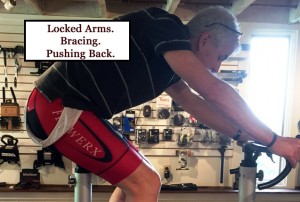 Other riders will do what we discussed in the article about over-rotation of the pelvis and slide forward if their reach is too long. These riders will more likely have soft tissue issues at the front of the saddle.
Other riders will do what we discussed in the article about over-rotation of the pelvis and slide forward if their reach is too long. These riders will more likely have soft tissue issues at the front of the saddle.
• Saddle Too Far Back: This will often create similar responses to the reach being too long.
• Saddle Too Far Forward: Not as common, but still one of the contributors to having too much weight in the sit bones, a saddle that is too far forward will encourage the rider to push back into their sit bones as the weight of the upper body always feels like it is coming forward.
• Horizontal Seat Angle: Being too high or too low in the saddle nose can contribute to pressure in the sit bones. Too low in the nose makes the rider feel like they slide forward and thus they might brace and push back while being too high in the nose can put pressure up-front to a degree that the rider pushes back and hunches in the back to pull the pressure off the front of the saddle. For most riders, just a degree or two off level is where they should be. Small (1 degree or less) changes in horizontal saddle angle can make a big difference for some riders and the direction to go can sometimes be counter-intuitive. For example, a rider may feel pressure at the nose of the saddle and logically think the nose needs to come down when what they really need is a little more nose up so that it is easier for them to stay further back and off the nose.
• Bars Too Low: If the handlebar position is lower than what the rider can support with their core abdominal muscles in a sustainable manner, they will frequently bend in the mid back (hunching in kyphosis) or over-extend their back (lordosis) and use the back muscles to support them instead. This can drive pressure downward or backward (depending) into the the sit bones.
• Saddle Selection: A saddle that is not a good width or that, often more importantly, does not taper in a way that aligns well with the angle of the rider’s pelvis can be a factor as well. For example, a saddle that might be wide enough, but that tapers too abruptly could make the rider feel under-supported when they roll their pelvis into a neutral position and thus encourage them to get uneven pressure on their sit bones. Especially for riders who lack fat padding, in addition to taper angle and width, having a saddle with a little more padding (something often not recommended for some other saddle discomfort issues) at the sit bone contact points on the saddle can be important as well. We have recently started working with Reform, who offers customizable saddles as well that can be molded to your sit bones in-shop to help balance out pressure. We look forward to getting more riders on these saddles to see the long-term results, but the company does guarantee improvement.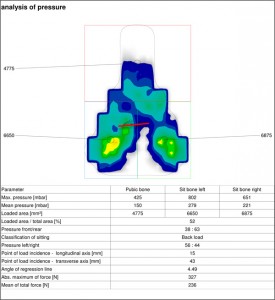
Information on additional postural variables can be found in some of our other posts on saddle discomfort, including the article “Stop Looking for the Best Bike Seat & Start Solving the Real Issue”.
How Can a Professional Fitting at Fit Werx Help?
In a Fit Werx bike fitting, we spend a significant portion of the fitting discussing and working on posture and pedaling technique items on the bike with many riders. Why? Because riders frequently don’t know what neutral posture on a bike looks or feels like and even the best fit bike in the world will not solve some problems if the rider is not using the right technique. We use a gebioMized pressure scanner to track pressure during your fitting and we provide you with before and after motion capture video and still shots from your fit session so that you can review the results in the future and continue to work on things. If you have had a fitting with us at Fit Werx in the past and are still having saddle issues, start by looking at your videos and reviewing the comments related to each. If that doesn’t give you insight, contact us and let’s talk!
I want to reinforce that optimized postural and technique items are not easy for many riders to understand or change. It took a lot of repetition for many of the current habits to form and it will likely take a lot of repetitions to encourage new positive habits to develop. Most riders need to change their muscle recruitment and support structure, on and off the bike, to achieve their comfort and performance potential on the bike in the long-term. These are all reasons why working with a qualified posture and technique based bike fitter (a “Bike Fit 2.0” fitter) in combination with a Postural Restoration specialist (often a physical therapist with a specialty in Postural Restoration) can be so crucial to truly making change and creating a solution to your saddle woes. After you understand what you need to do, it can take a lot of practice to train yourself to actually do it and solve issues like sit bone pain on the bike in the long-term… Click the links to learn more about our fit process and qualifications.
Fit Werx, voted “America’s Best Bike Shop” and named by Bicycling Magazine as a “Must Visit” bike shop, has locations outside of NYC in Ridgefield Park, NJ, in Peabody, MA and near Burlington, VT and Stowe, VT in Waitsfield. Fit Werx is changing the way people buy bicycles through their Rider First Bike Fittings and Rider Matched approach to bike sales. Don’t gamble on your next bike or your fit! Contact us for more information.
